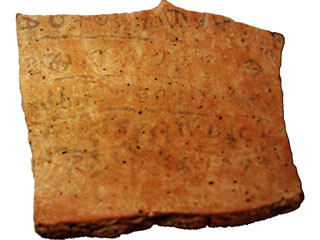10th Century Hebrew Inscription on Pottery from Khirbet Qeiyafa, Israel Confirms Biblical Claims

Introduction
To the surprise of many skeptics, an ancient Hebrew inscription, dated to the 10th century B.C. was discovered in 2006. Now, the most ancient example of the Hebrew language has been found on a pottery shard in Khirbet Qeiyafa, 20 miles southwest of Jerusalem, near the Elah Valley in Israel.1
New evidence
The archaeological site of Khirbet Qeiyafa is the location of a massively fortified city of megalithic stones 6-9 ft tall.2 In 2008, two city gates were discovered, which was very unusual for cities of that time (which usually had only one gate). This unusual characteristic clearly identified the city as being the biblical Sha‛ărayim, which has the meaning of "double gate."3 The city is mentioned three times in the Old Testament (Joshua 15:36, 1 Samuel 17:52 and 1 Chronicles 4:31).4
The pottery shard containing the inscription was discovered by Professor Yosef Garfinkel in 2008. It was translated by Professor Gershon Galil of the Department of Biblical Studies at the University of Haifa. The full translation of the inscription on the pottery shard reads:
- you shall not do [it], but worship the [Lord].
- Judge the sla[ve] and the wid[ow] / Judge the orph[an]
- [and] the stranger. [Pl]ead for the infant / plead for the po[or and]
- the widow. Rehabilitate [the poor] at the hands of the king.
- Protect the po[or and] the slave / [supp]ort the stranger.1
The inscription has similar content to several Old Testament passages, including Isaiah 1:17, Psalms 72:3, Exodus 23:3.5
Conclusion 
The discovery of the 10th century B.C. Hebrew city of Sha‛ărayim at Khirbet Qeiyafa, Israel confirms the existence of a Hebrew kingdom during the period of the reigns of David and Solomon as described in the Old Testament. The discovery of a pottery shard containing an ancient Hebrew inscription shows that the Hebrew language was already in existence and makes it likely that the Hebrews were already recording their history in written records at that time.
Related Pages 
- Archeology Confirms Biblical Commandments in 10th Century at Khirbet Qeiyafa, Israel
- Early (10th Century B.C.) Evidence of Written Hebrew Language at Tel Zayit, Israel
- Gabriel's Vision Stone Tablet: Prophecy of the Coming Messiah Jesus?
- Old Testament Dates of Solomon and Egyptian King Shishak Confirmed by Archeology
- Carbon-14 Dating of Copper Smelting in Edom (Jordan) Confirm Biblical Date of King Solomon's Kingdom
- Old Testament Dates of Edomite Kingdom Confirmed by Archeology
- No Proof for the Exodus? - The potential role of Thera and 14C dating of the destruction of Jericho
- Hezekiah's Siloam Tunnel Confirmed Through C-14 Dating
- Early (3rd Century A.D.) Christian Church at Megiddo, Israel
- Seal of Queen Jezebel Confirms Her Existence from the Old Testament Books of the Kings
- Seal of Gedaliah, Son of Pashur, Confirms the Existence of One of Jeremiah's Persecutors
- Cuneiform Receipt from King Nebuchadnezzar's Court Confirms Detail of Old Testament Book of Jeremiah
References 
- Most ancient Hebrew biblical inscription deciphered at University of Haifa.
- Yosef Garfinkel and Saar Ganor. 2008. Khirbet Qeiyafa: Sha`arayim. Journal of Hebrew Scriptures 8: Article 22.
- Brown-Driver-Briggs' Hebrew Definitions:
sha‛ărayim שׁערים (Strong's H8189)
Shaaraim = "double gate"
- a town in Judah
- a town in Simeon
A Related Word by BDB/Strong's Number: dual of H8179 - In the lowland: Eshtaol and Zorah and Ashnah, and Zanoah and En-gannim,
Tappuah and Enam, Jarmuth and Adullam, Socoh and Azekah, and
Shaaraim and Adithaim and Gederah and
Gederothaim; fourteen cities with their villages. (Joshua 15:33-36)
The men of Israel and Judah arose and shouted and pursued the Philistines as far as the valley, and to the gates of Ekron. And the slain Philistines lay along the way to Shaaraim, even to Gath and Ekron. (1 Samuel 17:52)
They lived at Beersheba, Moladah and Hazar-shual, at Bilhah, Ezem, Tolad, Bethuel, Hormah, Ziklag, Beth-marcaboth, Hazar-susim, Beth-biri and Shaaraim. These were their cities until the reign of David. (1 Chronicles 4:28-31) - Learn to do good; Seek justice, Reprove the ruthless, Defend the
orphan, Plead for the widow. (Isaiah 1:17)
Let the mountains bring peace to the people, And the hills, in righteousness. (Psalm 72:3)
nor shall you be partial to a poor man in his dispute. (Exodus 23:3)
http://www.godandscience.org/apologetics/ancient_hebrew.html
Last Modified January 12, 2010



